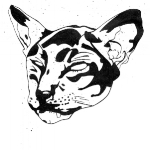GRAUKUNST - A Shit In The Face of History - 2014
Alan Vega
Photo by Maarten Nauw
Richard Fekner
Alan Vega
GRAUKUNST - A Shit In The Face Of History - 16 January - 16 February 2014
Grauzone' first exhibition took place at the second festival edition (2014) which presented top artists who’s work is inspired by, connected with or rooted in the music, art and culture of the 1980s. The subtitle is derived from the foreword of Lydia Lunch in ‘No Wave. Post-punk. Underground. New York. 1976-1980’ by Thurston Moore and Byron Coley, about the chaotic, interconnected character of the New York underground at the time: ‘The anti-everything of No Wave was a collective caterwaul that defied categorisation, defiled the audience, despised convention, shit in the face of history, and then split. It’s only a movement in retrospect.’
We are interested in the cross-over between disciplines during this period and aim to reflect this in the connections between the exhibition and the program of Grauzone Festival. The exhibition is not about looking back, but about connecting past and present and about reflecting an ‘anti-everything attitude’: A Shit In The Face Of History. Participating artists were: Alan Vega, Tracey Emin, Richard Kern, John Fekner, Glenn Kessler, Xenia Gottenkieny and Natasja Alers.
The exhibition took place at the Melkweg Gallery in Amsterdam.
Richard Fekner
GRAUKUNST – A Shit In The Face Of History
New York City, 1980: the streets of down-town Manhattan were the scene of empty plots surrounded by barbed wire, shuttered graffiti-covered storefronts and dilapidated buildings covered in layers of old posters. New York at the time was seedy, rough and dangerous. The city was on the brink of bankruptcy, Times Square was the city's de facto red light district.
This was the habitat of three of the artists presented here: Richard Kern, Alan Vega and John Fekner. Altough each one has his own distinct background, they are all unmistakenly rooted in the tumultuous Factory-inspired, underground New York culture of the 1970s and 1980s, hotbed of glam, punk, post-punk and no wave.
American street art pioneer John Fekner first started making his confrontational works on the streets in the 1970s, painting huge statements on burnt-out buildings in the ghetto of New York’s South Bronx: ‘Decay’, ‘America’ and ‘Broken Promises’. Meanwhile Alan Vega fronted controversial proto-punk/ no wave electro duo Suicide.
Musicians, film makers, artists, designer and performance artists flocked to the area called the Lower East Side, where rents were cheap and buildings were waiting to be squatted. They joined the ranks of junkies, freaks and vagabonds who called the area their home, influencing each other's work in a vibrant, anti-authoritarian, drug-fuelled no wave scene. While bands such as Teenage Jesus and the Jerks experimented with sound and performance, film maker Richard Kern explored the dark side of the human psyche with his outspoken sexual imagery.
Lydia Lunch was a key figure of the scene, fronting the band Teenage Jesus and the Jerks and starring in many films of the no wave cinema, most notably Richard Kern's 'Fingered'. Reflecting on the scene, she wrote: ‘The anti-everything of No Wave was a collective caterwaul that defied categorization, defiled the audience, despised convention, shit in the face of history, and then split. It’s only a movement in retrospect’.
To carefully place this movement in its historical context however, is to render it harmless. In a way, we have no choice: Amsterdam, 2014 is a very different place from the New York – or Amsterdam for that matter – of the 1980s. However, over the years the anti-everything attitude of no wave resurfaces time and again, in different forms.
It is alive and well in recent work of Alan Vega, whose light installations (‘visual punk’) criticize idolatry within American popular culture or in the non-conformist work of artist Tracey Emin, who came into her own in the underground of Thatcher-era Britain. Today's underground is the breeding ground of artists who share the uncompromising attitude, do it yourself approach, raw forms, urgency and interdisciplinarity of these pioneers.
The collages of Rotterdam-based artist Glenn Kessler explore the borderlands between the analogue and digital world, reflecting the constant bombardment of images in our on- and offline society. Musician, veejay and artist Xenia Gottenkieny is similarly inspired by the Internet to create her raw, fragmented images, while the sculptures of Natasja Alers with their organic, visceral shapes confront the spectator with an uneasy sense of sexuality. Rather than contextualising and defining, GRAUKUNST reflects the 'collective caterwaul' of the underground then and now, connecting past and present: a shit in the face of history.
Leonor Jonker
Left: Richard Kern, Lydia holds tits
Photo by Maarten Nauw






